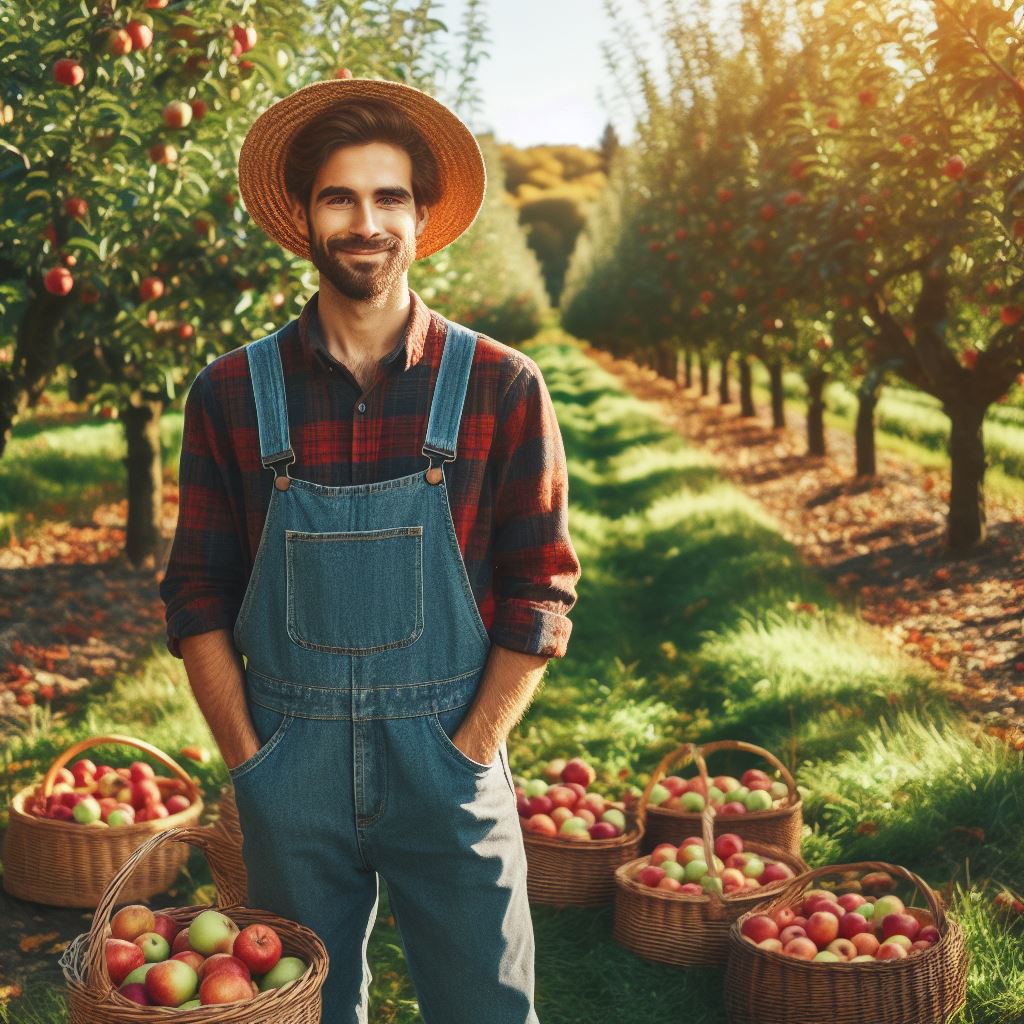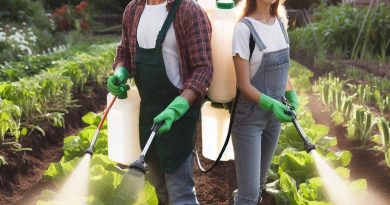Apple Picking: Timing for Perfect Fruit
Last Updated on February 6, 2024
Introduction
Hook: The joy of apple picking and the search for the perfect fruit
Apple picking is an activity that brings joy to many people, young and old alike. There is something special about strolling through the orchard, reaching up into the leafy branches, and plucking a ripe, juicy apple straight from the tree.
However, the search for that perfect fruit can be a challenge.
Brief overview of the importance of timing for optimal apple quality
Timing is crucial when it comes to picking apples at their peak of flavor and quality. The fruit needs to be fully matured but not overripe. This delicate balance ensures that the apples are sweet, crisp, and bursting with flavor.
Thesis statement: Exploring the factors to consider for picking apples at the perfect time
Several factors play a role in determining the optimal time for apple picking. The variety of the apple is one important factor. Different varieties have different ripening times, so it is essential to know when each type is at its best.
Another factor to consider is the weather. Warm temperatures and sunlight help the apples ripen, while cooler temperatures slow down the process.
Timing your apple picking excursion during a period of favorable weather can greatly increase the chances of finding perfectly ripe apples.
The condition of the apple is also vital. Inspect the skin for any blemishes or bruising, as these can indicate the fruit is past its prime. A firm texture and vibrant color are indicators of a ripe apple ready to be picked.
Basically, picking apples at the perfect time requires careful consideration of various factors.
By understanding the ripening times of different apple varieties, monitoring the weather conditions, and paying attention to the condition of the fruit, you can ensure a successful apple picking experience with the most delicious and high-quality apples.
So grab a basket, head to the orchard, and start searching for that perfect apple!
Understanding Apple Ripening
Explanation of the apple ripening process
Maturation stages of an apple
- Immature stage: Apple is firm, green in color, and lacks sweetness.
- Maturation stage: Apple begins to soften, sugars increase, and flavor develops.
- Overripe stage: Apple becomes mushy, and flavor deteriorates.
Changes in color, texture, and flavor during ripening
- Color: Green apples turn red or yellow as they ripen due to the breakdown of chlorophyll.
- Texture: Apples become less crunchy and more tender as they ripen.
- Flavor: The sweetness of apples intensifies as sugars increase during ripening.
During the apple ripening process, several changes can be observed in terms of color, texture, and flavor. Understanding these changes is essential for picking apples at the perfect time to enjoy the best quality fruit.
Factors influencing apple ripening
Temperature
Cool temperatures slow down the ripening process, extending the fruit’s shelf life.
Warmer temperatures accelerate ripening, leading to a shorter shelf life.
Ethylene gas production
Apples produce ethylene gas, which acts as a natural ripening agent.
Ethylene gas promotes fruit softening, color changes, and flavor development.
Harvesting time
Picking apples too early results in under-ripe and sour fruit with poor texture.
Delaying harvest too long leads to overripe and mushy apples with a loss of flavor.
Apple variety
Different apple varieties have varying ripening times and optimum maturity stage.
Understanding the specific characteristics of each variety is crucial for timing the harvest.
Considering these factors, it is important to choose the appropriate time for apple picking to ensure the best flavor and texture.
Methods to determine apple ripeness
Color and firmness
A change in apple color from green to red or yellow indicates ripening.
Slight pressure applied with fingers should result in a firm but not overly hard texture.
Seed color
Cutting open an apple and observing the color of the seeds can provide insight into ripeness.
Fully ripened apples usually have dark brown seeds, while under-ripe ones have white or pale seeds.
Taste test
Sampling an apple from the tree allows tasting for the desired sweetness and flavor.
If the apple tastes ripe and pleasant, it is an indication that it is ready for picking.
It is advisable to use a combination of these methods to accurately determine the ripeness of the apples and ensure the best quality harvest.
To summarize, understanding the apple ripening process is crucial for successfully picking ripe and delicious fruit.
By considering the maturation stages, changes in color, texture, and flavor, as well as the factors influencing ripening and the methods to determine ripeness, apple enthusiasts can ensure they enjoy the perfect fruit.
Picking apples at the right time guarantees optimal sweetness, texture, and overall quality, resulting in a satisfying apple picking experience.
Read: Maximizing Wheat Yields: Harvesting Insights
Factors Affecting Apple Picking Timing
Different apple varieties and their ripening schedules
Popular apple varieties and their typical ripening periods
When planning for apple picking, it is essential to be aware of the ripening schedules of different apple varieties. This knowledge allows you to maximize the quality and flavor of the fruit you harvest.
Some popular apple varieties and their typical ripening periods include:
Early-season apples, such as Gala and McIntosh, typically ripen in late summer or early fall.
Mid-season apples, including Jonagold and Golden Delicious, usually ripen in mid-fall.
Late-season apples, like Granny Smith and Fuji, typically ripen in late fall or early winter.
Understanding the ripening periods of these apple varieties ensures that you pick the fruits at their peak flavor and crunchiness.
Researching specific apple varieties for local harvest times
Since apple ripening times can vary depending on the location, it is crucial to research the specific apple varieties grown in your area.
Local agricultural extension offices or apple orchards can provide information on when different apple varieties usually reach maturity in your region.
This research helps you plan your apple picking excursion at the optimal time when the fruits are perfectly ripe and ready for harvesting.
Weather conditions and their impact on apple ripening
The role of temperature and sunlight in apple development
Temperature and sunlight play vital roles in the development and ripening of apples. Apple trees require a specific amount of heat and light to mature their fruits.
During the growing season, moderate temperatures, preferably between 60°F and 75°F (15°C and 24°C), facilitate proper apple ripening. Adequate sunlight exposure helps in the production of sugars and flavor compounds that give apples their characteristic taste.
Effects of excessive rain, frost, or drought on apple ripening
Extreme weather conditions can significantly impact apple ripening. Excessive rain can cause the fruits to absorb excess moisture, leading to reduced flavor and texture quality.
Frost, especially during the flowering period, can damage the apple blossoms and reduce fruit production. Drought conditions can also hinder apple development by affecting tree health and reducing the sugars in the fruits.
Monitoring weather patterns and avoiding extreme weather conditions can help ensure a successful apple picking experience with high-quality fruits.
Tree health and fruit quality indicators
Checking for signs of maturity, such as fruit firmness and color
When determining the optimal apple picking time, it is crucial to evaluate the signs of fruit maturity. Firmness and color are essential indicators of fruit readiness.
Apples should have a firm texture indicating that they are not overly ripe or still too young. The fruit color should be vibrant and uniform across the surface, reflecting maturity.
Evaluating tree health and vigor as indicators of fruit quality
The health and vigor of the apple tree also play a significant role in determining fruit quality. Healthy trees with robust growth are more likely to produce high-quality apples.
Inspect the tree for any signs of disease, pests, or nutrient deficiencies. A healthy tree will have strong branches, vibrant foliage, and an overall vigorous appearance.
By considering the factors above and carefully observing apple varieties, weather conditions, and tree health, you can time your apple picking adventure to achieve the perfect fruit.
Remember to plan ahead, gather information, and thoroughly assess the apples for the best results. Happy apple picking!
Read: Efficient Cotton Picking Methods Explained

Techniques for Determining Apple Readiness
When it comes to apple picking, timing is crucial as it greatly affects the quality and taste of the fruit. To determine the perfect time for apple harvest, various techniques can be employed.
This section will explore two main methods: apple taste-testing and picking based on color and firmness.
Apple taste-testing methods
Describing the flavor profiles of under-ripe, ripe, and overripe apples
One effective way to determine apple readiness is through taste-testing. By understanding the flavor profiles of underripe, ripe, and overripe apples, you can identify the desirable characteristics of a perfectly ripe fruit.
Under-ripe apples tend to have a tart or sour taste, while ripe apples exhibit a balanced combination of sweetness and acidity. Overripe apples may become mushy and overly sweet.
Sampling apples from different trees to compare taste
Variation in taste can exist among apple trees, even within the same variety. Sampling apples from different trees allows for a comparison of taste and can assist in determining the optimal time for picking.
It is recommended to taste apples from various trees throughout the orchard to ensure a representative sample.
Picking apples based on color and firmness
Identifying the optimal color and firmness for different apple varieties
Color and firmness serve as visual indicators of apple readiness. Different apple varieties have unique optimal color and firmness characteristics.
For example, some varieties are best when their skin turns a deep shade of red, while others should have a yellow or green undertone. Firmness can also vary, with some apples being crisp and others more delicate.
By familiarizing yourself with the specific requirements of each variety, you can make informed decisions during the picking process.
Gentle twisting motion for easy removal of ripe apples
When picking apples, it is essential to handle them with care to avoid damaging the fruit or the tree. A gentle twisting motion should be used to detach ripe apples from their stems.
Ripe apples will naturally separate easily from the tree, while unripe ones may require more force. By employing this technique, you can harvest ripe apples without causing unnecessary harm.
Generally, determining the perfect time for apple picking involves employing various techniques. Apple taste-testing allows for a comprehensive understanding of the flavor profiles of different stages of ripeness.
Sampling apples from different trees assists in identifying the optimal time for harvest. Picking based on color and firmness ensures that you select apples with the ideal characteristics for each variety.
By utilizing these techniques, you can ensure a bountiful harvest of delicious and perfectly ripe apples.
Read: Post-Harvest Grain Storage: Essential Guide
Tips for Apple Picking Success
Apple picking is an enjoyable and rewarding activity that allows you to experience the beauty of nature and taste the delicious fruits it bears.
To make the most out of your apple picking adventure, it is essential to plan ahead and follow a few tips for a successful outing.
Planning a visit to the apple orchard
- Contact local orchards for information on apple varieties and ripening times. Different apple varieties have different ripening periods, so it is important to know which ones will be available when you plan to visit. This will help you ensure that you pick apples that are at their peak of flavor.
- Choose the right day and time to avoid crowds. Weekends and holidays are typically busy at apple orchards, so try to plan your visit on a weekday if possible. Early mornings or late afternoons are also good times to visit to beat the crowds.
Preparing for apple picking
- Provide appropriate clothing and footwear. Wear comfortable shoes and dress in layers, as weather conditions can change throughout the day. It is also a good idea to bring a hat to protect yourself from the sun.
- Bring necessary tools or containers for collecting apples. Many orchards provide bags or baskets for picking, but it is helpful to have your own containers or boxes to transport the apples. A sturdy backpack can also come in handy for carrying smaller items like water bottles or snacks.
Ensuring proper apple storage to maintain quality and freshness
- Store apples in a cool and dark place. Apples can be kept in the refrigerator or a cool cellar to maintain their freshness. Avoid storing them near other fruits, as apples release a gas called ethylene which can cause other fruits to ripen more quickly.
- Sort and use apples based on ripeness to avoid spoilage. Apples that are overripe or bruised should be used immediately or discarded to prevent them from spoiling the other apples. Use the firmer and less ripe apples first, as they will have a longer storage life.
Following these tips will help you have a successful apple picking experience and ensure that you bring home the best apples possible.
So, gather your friends and family, put on your apple-picking attire, and head to the nearest orchard for a fun-filled day of picking and enjoying these crisp and juicy fruits!
Read: Optimal Soybean Harvesting: When & How
Conclusion
Recap of the significance of timing for apple picking
Timing plays a crucial role in apple picking as it determines the maturity of the fruit, ensuring optimal taste and texture.
Emphasizing the pleasure of finding the perfect apple through proper timing
By picking apples at the right time, you can savor the joy of biting into a sweet, juicy fruit that is bursting with flavor.
Encouragement to explore local apple orchards and enjoy the apple picking experience
Take advantage of the fall season by visiting local apple orchards, immersing yourself in nature, and enjoying the unique experience of apple picking.
Overall, timing is everything when it comes to apple picking. By understanding the importance of picking apples at their peak maturity, you can indulge in the ultimate fruit experience.
The pleasure of biting into a perfectly ripe apple is unmatched, with its crispness and sweetness delighting your taste buds.
So, make sure to plan a visit to your nearest apple orchard, where you can not only pick apples but also immerse yourself in the beauty of the surroundings.
Don’t miss out on this delightful autumn activity that offers a fun-filled day for the entire family. Enjoy the seasonal charm and create lasting memories as you relish the excitement of apple picking.


